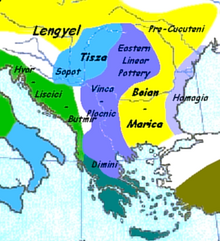Dimini culture
|
Dimini Διμήνι |
|
|---|---|
| Coordinates: 39°21′N 22°53′E / 39.350°N 22.883°ECoordinates: 39°21′N 22°53′E / 39.350°N 22.883°E | |
| Country | Greece |
| Administrative region | Thessaly |
| Regional unit | Magnesia |
| Municipality | Volos |
| Municipal unit | Aisonia |
| Community | |
| • Population | 2,297 (2011) |
| Time zone | EET (UTC+2) |
| • Summer (DST) | EEST (UTC+3) |
 |
|
| Period | Neolithic Europe |
|---|---|
| Dates | circa 5000 BCE — circa 4400 BCE |
| Preceded by | Sesklo culture |
| Followed by | Neolithic Greece |
Dimini (Greek: Διμήνι; older form: Diminion) is a village near the city of Volos, in Thessaly (central Greece), in Magnesia. It was the seat of the municipality of Aisonia. The name Aisonia dates back to ancient times and it is the westernmost place in the Volos area. The Dimini area contains both a Mycenean settlement and a Neolithic settlement. The Neolithic settlement in Dimini was discovered near the end of 19th century and was first excavated by the archaeologists Christos Tsountas and Valerios Stais.
The palace of ancient Iolcos is believed to be located in modern-day Dimini, where a Mycenaean palace was excavated recently.
In 1886, Lolling and Wolters excavated the Mycenean tholos tomb known as Lamiospito. In 1901, Valerios Stais discovered the tholos tomb on the hill of the Neolithic settlement. He worked at the Dimini settlement with Christos Tsountas from 1901 up until 1903. In 1977, George Chourmouziadis continued excavations at the Neolithic settlement. Excavations of the Mycenean settlement in Dimini began in 1980 by V. Adrimi-Sismani. In 2001 the excavations uncovered a Mycenaean city and palace complex they believe could be part of ancient Iolkos. A stone weight and a sherd inscribed with Linear B writing were also uncovered.
The "invasion theory" states that the people of the Neolithic Dimini culture were responsible for the violent conquest of the Sesklo culture at around 5000 BC. Moreover, the theory considers the "Diminians" and the "Seskloans" as two separate cultural entities. However, I. Lyritzis provides a different story pertaining to the relations between the Dimini and the Sesklo cultures. He, along with R. Galloway, compared ceramic materials from both Sesklo and Dimini utilizing thermoluminescence dating methods. He discovered that the inhabitants of the settlement in Dimini appeared around 4800 BC, four centuries before the fall of the Sesklo civilization (ca. 4400 BC). Lyritzis concluded that the "Seskloans" and "Diminians" coexisted for a period of time.
...
Wikipedia

